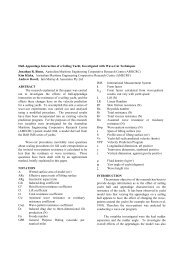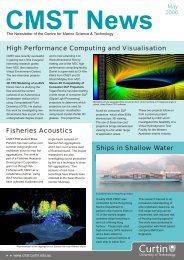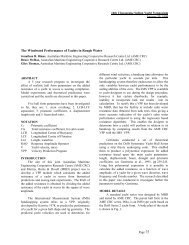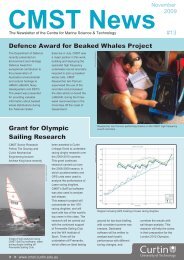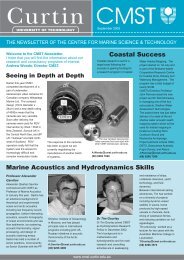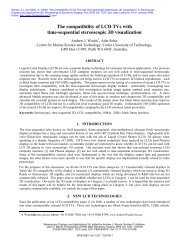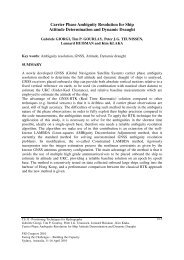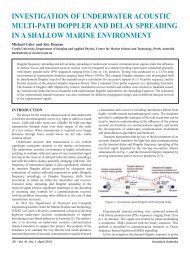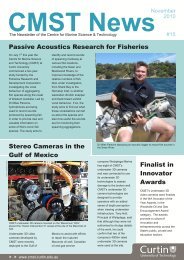Blue whale calling in the Rottnest trench-2000, Western ... - ANP
Blue whale calling in the Rottnest trench-2000, Western ... - ANP
Blue whale calling in the Rottnest trench-2000, Western ... - ANP
You also want an ePaper? Increase the reach of your titles
YUMPU automatically turns print PDFs into web optimized ePapers that Google loves.
4) Discussion<br />
A series of three long tonal sounds (components I-III) repeated <strong>in</strong> a regular pattern, typical of<br />
blue <strong>whale</strong> calls and attributed to <strong>the</strong>m here, plus a 20 Hz click<strong>in</strong>g signal of unknown orig<strong>in</strong>,<br />
were found to predom<strong>in</strong>ate <strong>in</strong> sea noise records made over January to April <strong>2000</strong> <strong>in</strong> <strong>the</strong> <strong>Rottnest</strong><br />
<strong>trench</strong> west of Perth. Time averaged sea noise spectra over <strong>the</strong> band 15-100 Hz were dom<strong>in</strong>ated<br />
by <strong>the</strong> two call types over this period. Up to n<strong>in</strong>e <strong>call<strong>in</strong>g</strong> blue <strong>whale</strong>s were evident at a given<br />
time <strong>in</strong> a cont<strong>in</strong>ual sequence of 4827 x 90 s records, each separated by 10 m<strong>in</strong>utes and made over<br />
a 33.5 day period. The 20 Hz click<strong>in</strong>g signal was unlike any described calls, notably f<strong>in</strong> <strong>whale</strong><br />
calls which are similar but always seem to <strong>in</strong>volve a frequency sweep (ie. down-sweeps <strong>in</strong><br />
Watk<strong>in</strong>s 1981; Watk<strong>in</strong>s et al 1987; or Thompson et al 1992). The 20 Hz click<strong>in</strong>g did not show<br />
any frequency sweep thus <strong>the</strong> orig<strong>in</strong> of this call type is unknown. The persistent sight<strong>in</strong>gs of blue<br />
<strong>whale</strong>s <strong>in</strong> <strong>the</strong> study area by aerial and boat surveys suggests <strong>the</strong> 20 Hz click<strong>in</strong>g call was possibly<br />
made by blue <strong>whale</strong>s. Two o<strong>the</strong>r low frequency call types, aga<strong>in</strong> of unknown orig<strong>in</strong>, were<br />
recorded, as were air-gun signals from a geophysical survey vessel some 280 km north, dolph<strong>in</strong><br />
signals, and identifiable ship noise <strong>in</strong> 27% of samples.<br />
The presence of multiple blue <strong>whale</strong> callers <strong>in</strong> samples was common, although when averaged<br />
over all samples from a deep water site with excellent long range propagation <strong>the</strong> mean number<br />
of callers at any given time (a 90 s block <strong>in</strong> analysis) was only slightly greater than one (1.02 ±<br />
0.03 / 90 s block). <strong>Blue</strong> <strong>whale</strong> <strong>call<strong>in</strong>g</strong> was consistently found to be greater at night as compared<br />
to dur<strong>in</strong>g <strong>the</strong> daytime, by a factor of 2.2 ± 0.06. This has not been reported for blue <strong>whale</strong>s<br />
before, but is consistent with studies of o<strong>the</strong>r baleen <strong>whale</strong> species. For example Watk<strong>in</strong>s et al<br />
(1987) found a slightly greater number of f<strong>in</strong> <strong>whale</strong> calls at night as compared to day, as did<br />
McCauley et al (1996) for humpback <strong>whale</strong> songs.<br />
On a seasonal scale blue <strong>whale</strong> <strong>call<strong>in</strong>g</strong> blue has been shown to have seasonal trends (Stafford et<br />
al 1999 from <strong>the</strong> eastern tropical Pacific, McDonald and Fox 1999 from Oahu, Hawaii) as have<br />
20 Hz sweeps from f<strong>in</strong> <strong>whale</strong>s (Watk<strong>in</strong>s, 1981; Watk<strong>in</strong>s et al 1987, McDonald and Fox, 1999).<br />
The sampl<strong>in</strong>g made here was not of long enough duration to show any seasonal trends, although<br />
<strong>the</strong> arrival of blue <strong>whale</strong>s <strong>in</strong> <strong>the</strong> <strong>trench</strong> several weeks after <strong>the</strong> beg<strong>in</strong>n<strong>in</strong>g of <strong>the</strong> study period<br />
suggests that seasonal patterns would occur off <strong>Rottnest</strong>.<br />
Each of <strong>the</strong> three blue <strong>whale</strong> call components was dom<strong>in</strong>ated by constant or slowly vary<strong>in</strong>g<br />
tones, over <strong>the</strong> range 18-26 Hz, although harmonics up to 100 Hz were evident <strong>in</strong> all components<br />
received at short range. A series of 65-66 Hz pulses were evident <strong>in</strong> all components, especially<br />
so <strong>in</strong> <strong>the</strong> third. These pulses seemed to occur <strong>in</strong>dependently of <strong>the</strong> 18-26 Hz tones and were<br />
possibly from a separate source with<strong>in</strong> <strong>the</strong> animal. The multipath field of <strong>the</strong>se pulses was used<br />
to localise several <strong>call<strong>in</strong>g</strong> animals from with<strong>in</strong> 6.2 km range, although identify<strong>in</strong>g <strong>the</strong> appropriate<br />
sets of bounce paths was difficult.<br />
A search rout<strong>in</strong>e was developed to automatically identify blue <strong>whale</strong> call components and this<br />
used to count <strong>the</strong> number of callers and return <strong>the</strong> received level of components. The search<br />
technique was based on a modified version of a spectrogram correlation technique. Problems<br />
were found with us<strong>in</strong>g conventional cross correlation techniques. These <strong>in</strong>cluded <strong>the</strong> long length<br />
of signal components, (> 40 s for <strong>the</strong> type I), many overlapp<strong>in</strong>g components (up to n<strong>in</strong>e callers /<br />
90 s ), components hav<strong>in</strong>g similar frequency contents (eg. 19 Hz tone at beg<strong>in</strong>n<strong>in</strong>g of type I and<br />
19 Hz tone of type III), <strong>the</strong> presence of closely spaced 20 Hz click<strong>in</strong>g, and ship tones. The<br />
modified search algorithm used a spectrogram subtraction technique to provide a first<br />
identification, which was confirmed or rejected by <strong>the</strong> presence of <strong>the</strong> appropriate harmonics.<br />
The number of type II components per 90 s block and type III components <strong>in</strong> <strong>the</strong> first portion of<br />
51



